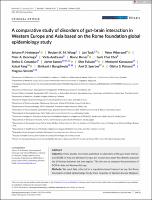| dc.contributor | Vall d'Hebron Barcelona Hospital Campus |
| dc.contributor.author | Hreinsson, Johann Pall |
| dc.contributor.author | Wong, Reuben |
| dc.contributor.author | Tack, Jan |
| dc.contributor.author | Whorwell, Peter |
| dc.contributor.author | Benninga, Marc A. |
| dc.contributor.author | Andresen, Viola |
| dc.contributor.author | Santos, Javier |
| dc.date.accessioned | 2023-06-29T06:35:07Z |
| dc.date.available | 2023-06-29T06:35:07Z |
| dc.date.issued | 2023-06 |
| dc.identifier.citation | Hreinsson JP, Wong RKM, Tack J, Whorwell P, Benninga MA, Andresen V, et al. A comparative study of disorders of gut–brain interaction in Western Europe and Asia based on the Rome foundation global epidemiology study. Neurogastroenterol Motil. 2023 Jun;35(6):e14566. |
| dc.identifier.issn | 1365-2982 |
| dc.identifier.uri | https://hdl.handle.net/11351/9926 |
| dc.description | Functional constipation; Functional dyspepsia; Functional gastrointestinal disorders |
| dc.description.abstract | Objective
Many studies have been published on disorders of the gut–brain interaction (DGBI) in Asia and Western Europe, but no previous study has directly assessed the difference between the two regions. The aim was to compare the prevalence of DGBI in Asia and Western Europe.
Methods
We used data collected in a population-based Internet survey, the Rome Foundation Global Epidemiology Study, from countries in Western Europe (Belgium, France, Germany, Netherlands, Italy, Spain, Sweden, and the United Kingdom) and Asia (China, Japan, South Korea, and Singapore). We assessed DGBI diagnoses (Rome IV Adult Diagnostic Questionnaire), anxiety/depression (Patient Health Questionnaire-4, PHQ-4), non-GI somatic symptoms (PHQ-12), and access to and personal costs of doctor visits.
Results
The study included 9487 subjects in Asia and 16,314 in Western Europe. Overall, 38.0% had at least one DGBI; younger age, female sex, and higher scores on PHQ4 and PHQ12 were all associated with DGBI. The prevalence of having at least one DGBI was higher in Western Europe than in Asia (39.1% vs 36.1%, OR 1.14 [95% CI 1.08–1.20]). This difference was also observed for DGBI by anatomical regions, most prominently esophageal DGBI (OR 1.67 [1.48–1.88]). After adjustment, the difference in DGBI prevalence diminished and psychological (PHQ-4) and non-GI somatic symptoms (PHQ-12) had the greatest effect on the odds ratio estimates.
Conclusion
The prevalence of DGBI is generally higher in Western Europe compared to Asia. A considerable portion of the observed difference in prevalence rates seems to be explained by more severe psychological and non-GI somatic symptoms in Western Europe. |
| dc.language.iso | eng |
| dc.publisher | Wiley |
| dc.relation.ispartofseries | Neurogastroenterology & Motility;35(6) |
| dc.rights | Attribution 4.0 International |
| dc.rights.uri | http://creativecommons.org/licenses/by/4.0/ |
| dc.source | Scientia |
| dc.subject | Aparell digestiu - Malalties - Epidemiologia |
| dc.subject | Còlon irritable - Epidemiologia |
| dc.subject | Cervell |
| dc.subject | Qüestionaris |
| dc.subject.mesh | Irritable Bowel Syndrome |
| dc.subject.mesh | Surveys and Questionnaires |
| dc.subject.mesh | Brain |
| dc.title | A comparative study of disorders of gut–brain interaction in Western Europe and Asia based on the Rome foundation global epidemiology study |
| dc.type | info:eu-repo/semantics/article |
| dc.identifier.doi | 10.1111/nmo.14566 |
| dc.subject.decs | síndrome del colon irritable |
| dc.subject.decs | encuestas y cuestionarios |
| dc.subject.decs | cerebro |
| dc.relation.publishversion | https://doi.org/10.1111/nmo.14566 |
| dc.type.version | info:eu-repo/semantics/publishedVersion |
| dc.audience | Professionals |
| dc.contributor.organismes | Institut Català de la Salut |
| dc.contributor.authoraffiliation | [Hreinsson JP] Department of Molecular and Clinical Medicine, Institute of Medicine, Sahlgrenska Academy, University of Gothenburg, Gothenburg, Sweden. [Wong RKM] Department of Medicine, Yong Loo Lin School of Medicine, National University of Singapore, Singapore. [Tack J] Department of Molecular and Clinical Medicine, Institute of Medicine, Sahlgrenska Academy, University of Gothenburg, Gothenburg, Sweden. Translational Research Center for Gastrointestinal Disorders (TARGID), Department of Chronic Diseases and Metabolism (CHROMETA), KU Leuven, Leuven, Belgium. [Whorwell P] University of Manchester, Neurogastroenterology Unit, Wythenshawe Hospital, Manchester, UK. [Benninga MA] Emma Children's Hospital, Amsterdam UMC, University of Amsterdam, Pediatric Gastroenterology, Hepatology and Nutrition, Amsterdam, The Netherlands. [Andresen V] Department of Medicine, Israelitic Hospital, Hamburg, Germany. [Santos J] Laboratori de Fisiologia i Fisiopatologia Digestiva, Vall d'Hebron Institut de Recerca (VHIR), Barcelona, Spain. Servei d’Aparell Digestiu, Vall d'Hebron Hospital Universitari, Barcelona, Spain. Centro de Investigación Biomédica en Red de Enfermedades Hepáticas y Digestivas (CIBERHED), Instituto de Salud Carlos III, Madrid, Spain |
| dc.identifier.pmid | 36961016 |
| dc.identifier.wos | 000951828500001 |
| dc.rights.accessrights | info:eu-repo/semantics/openAccess |

 Private area
Private area Contact Us
Contact Us








